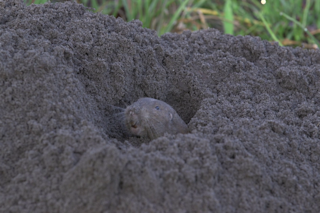On a morning in July it is clear and hot in Bismarck, North Dakota, and only slightly cooler in Bruce Boe’s office. The office, packed tight with computer data tapes, books, documents, and pamphlets about weather, sits in an old brick building separated by a parking lot and a green from the stark concrete tower that serves as the state’s capitol.
The buzz of an old air conditioner nearly drowns out normal conversation, but Boe, a strapping 6 foot 5 native of Montana dressed in jeans and cowboy boots, ignores the noise as he rushes through some paperwork. He’s trying to order a yellow chemical compound called silver iodide. Boe needs the substance, a salt, to accomplish a feat long promised by assorted hustlers, hucksters, and mystics, yet long viewed by skeptical scientists as impossible. Using this chemical, Boe says, he will make reluctant clouds rain. At the same time he will rob fierce hailstorms of their power
A cloud physicist and executive director of the North Dakota Atmospheric Resource Board, Boe heads one of the country’s longest-running programs to modify daily weather, a program in operation since 1961. Each summer, whenever angry storm clouds roll across western North Dakota, a small air force takes off from rural landing strips. When one of the planes reaches the base of a threatening thundercloud, the pilot flips a switch to release plumes of microscopic silver iodide particles. And when the particles meet cool moisture in the cloud, they--in theory--trigger the formation of welcome raindrops or tiny hailstones that fall from the sky before they have time to grow into large flying rocks of ice.
In this part of the country walnut-size hailstones are as destructive as a swarm of locusts. A hailstorm can turn a healthy wheat field into a useless mat of green pulp in less time than it takes a farmer to fill out a crop-insurance form.
The flying cloud seeders’ objective has been to break storms before such damage is done. But for most of the last 30 years, they couldn’t prove they were doing their job. One of the criticisms that’s always been leveled at modification people is, ‘You really don’t know what you’re doing,’ explains Boe, who has headed the seeding program since 1988. You go seed a cloud and it rains and the critics may say, ‘Well, you don’t know that you caused it. Maybe it was going to rain anyway.’ The problems went beyond proving cause and effect--sometimes the seeded clouds didn’t do anything.
The inner workings of storm clouds were something of a mystery to scientists. Even when they got rain after seeding, they weren’t able to say exactly what silver iodide did in the clouds to trigger it. All the seeders could do was point to water on the ground and chemicals in the air and claim there must be some connection.
That wasn’t good enough for the skeptics. I don’t think any reputable scientist would make a categorical statement that cloud seeding can really be a means of increasing water at the ground, says Peter Hobbs, a professor of atmospheric sciences at the University of Washington. There probably are a few who would say that, but they wouldn’t get much support from the general scientific community. As a result, more than 45 years after a scientist accidentally discovered how to use some laboratory chemicals to get ice crystals to form in a cloud, weather modification has become something of an orphan science. Clouds have proved to be quite difficult to control, and today the number of U.S. researchers active in the field would barely fill a large hot tub.
In the last decade, however, those who have stuck with the field have finally begun to peel away some of cloud seeding’s most basic mysteries. Like biologists exploring the essence of life, weather modification researchers have begun to look at clouds and seeding at the molecular level. By tracking seeding chemicals with new high-speed analyzers and computer programs, they have been able to follow the path of the seeds from the time they are released into a storm cloud until they form icy raindrops. They now have a good idea of the best clouds to seed, the best time in the clouds’ short life to seed them, and the best place to put those seeds. We’re not going to end droughts, and we’re not going to make a rain forest out of the Sahara and all that, Boe says. But we’ve come a long way toward understanding how ice and rain evolve.
Of course, for us to understand what Boe and his colleagues have learned, it helps to know a few basics about clouds. First, all air contains moisture. When warm air rises from Earth’s surface and begins to cool, some of the moisture condenses into tiny droplets, creating a cloud. The droplets are so small it takes a microscope to see them, and so light they float on the mildest airstream. Ultimately, the cloud is a mass of these droplets and air. More than 99 percent of every cloud is pure air.
Before they can become raindrops, snowflakes, or hailstones, the droplets have to jump across the air space between one another and come together, a million at a time, until they are heavy enough to drop to the ground. In the continental United States nature usually brings this about through something called the cold-rain process. Cold rain occurs only in clouds in which temperatures fall below the freezing point. Despite the extreme cold, cloud droplets are capable of remaining in an unfrozen state. Water doesn’t automatically freeze when it comes to thirty-two degrees, Boe says. It’s a funny substance. If it doesn’t have a pattern to follow, it won’t arrange itself in a crystalline form until it gets way colder than that, like minus forty degrees. But when a droplet of this supercooled liquid water encounters a stray particle of a substance such as clay, it receives a pattern. It acts like water binding to the sides of an ice cube tray in a freezer, and it forms a small ice crystal. Water vapor in the cloud then freezes directly onto the surface of this crystal, and the crystal gains weight and falls. Some of these falling droplets collide with one another and freeze together. Eventually the frozen water becomes too heavy to remain suspended in the cloud and falls to the ground.
Whether that frozen water falls as rain, snow, or hail depends on a variety of factors, including temperatures outside the cloud and air currents within. For instance, in a cloud with a very strong updraft, an ice crystal may grow into a very large hailstone before it becomes heavy enough to break through the updraft and fall to Earth.
Most temperate clouds are either too short-lived, too warm, too small, or simply lack enough droplets to give up their moisture in any form. Some, though, have relatively long lives of 20 minutes or more, have an abundance of droplets, and are at the right temperature for ice crystal formation, yet apparently don’t have enough natural seed particles to start the cold-rain process. So cloud seeders introduce chemicals that mimic the structure of ice and serve as a template for crystal formation. It’s a fake ice crystal, in effect, Boe says. We’re looking for situations where nature is basically deficient, and all we’re trying to do is get the ice phase going. Once you start it, nature takes it from there.
The idea got its start in 1946. Vincent Schaefer, then at the General Electric Research Laboratory in Schenectady, New York, was working with a cold chamber fashioned from a deep freezer, trying to find a chemical way to induce artificial clouds to snow or rain. It was summer and hot and humid. Schaefer worried that the chamber was getting too warm, so he slid in a chunk of dry ice (carbon dioxide frozen into a solid block). Immediately ice crystals formed in a cloud around the dry ice, and cloud seeding was born. Shortly after that, Schaefer’s colleague Bernard Vonnegut searched the literature until he found a chemical, silver iodide, that was almost exactly like ice in its molecular structure but could be carried and applied more easily. (Eighteen years later, and probably not coincidentally, the apocalyptic novel Cat’s Cradle--the chronicle of a superseed chemical called ice-nine that freezes the world--was published by Vonnegut’s brother, Kurt.)
Over the next 35 years researchers and policymakers pumped millions of dollars into cloud seeding while commercial cloud seeders peddled the technology, which was barely understood, to thirsty communities. Would-be weather modifiers conducted a series of expensive field experiments, seeding massive storm clouds over the course of many seasons in different parts of the United States. Typically they would try to catch falling water--in whatever form--in cuplike gauges on the ground. They would compare the amount collected with the amount in similar gauges under unseeded clouds and then attempt to draw conclusions about the effects of weather modification.
It’s been very frustrating to set out buckets to try to statistically determine the results, says Jeffrey Stith, a cloud physicist at the University of North Dakota who works with Boe’s team of cloud seeders. When we surveyed clouds in the seeded area and the nonseeded area, we had no way of knowing whether the seeded clouds were actually being treated effectively. And so we had no really good way of saying that we were doing a good job of comparing one cloud at one stage in its development with another cloud in another stage of development.
Predictably, the results of these experiments were mixed. By the late 1970s few researchers could agree on when, how, or even if seeding worked. Government enthusiasm for weather modification waned, and scientific enthusiasm--which tends to follow the grant money--did so as well. By the mid-1980s federal money for modification research had dropped to a few million a year, from nearly $25 million a year in 1981, and scientists had dropped out of the field.
Those who stayed, such as Stith and Boe, decided their study techniques had to change. They needed answers to some basic questions: Had the clouds they sent silver iodide into actually received the seed? What did the silver iodide do from the time it was released from an airplane until it left a cloud? What conditions affected a seeding agent’s performance? How could the effects of seeding be measured so that the results were reliable and certain?
In 1984 Stith began to answer these questions. Over the next three years he developed and refined a technique that used a tracer gas, sensitive detectors, and a complex computer program to follow silver iodide through a cloud. Initially, an airplane was flown into a cloud base, where Stith released the gas sulfur hexafluoride along with silver iodide. Air pollution studies using sulfur hexafluoride had shown that very small amounts of the chemical could be detected and measured with analyzers in less than a second, at least 60 times faster than it took airborne scientists to find and analyze silver iodide alone. We were only in the cloud for a few seconds, Stith says, so we needed some sort of tracer that we could detect quickly.
But the gas actually proved rather elusive when the researchers tried to pick it up with their sensors. There hadn’t been a lot of experiments of this kind, in which someone released something in a cloud and tried to follow it with an airplane, says Stith. We discovered that when we tried to go back into the cloud to find the tracer, we couldn’t. It disappeared, somehow, into thin air.
To improve their ability to find the gas, Stith’s group customized a computer program that uses wind measurements captured while the airplane is flying, hoping the program could predict the path of the released gas and plot how the plane would have to move to follow. It gave us kind of a homing pigeon on board the airplane, Stith says.
Once they mastered tracer-tracking techniques, Stith’s group was finally able to start looking at the details of cloud seeding. In 1987 the researchers used three aircraft working in tandem to put together a more complete picture of what the tracer looked like in the cloud. Stith found that once silver iodide is released from an airplane at the base of a storm cloud, an updraft usually rockets the chemical toward the cloud’s top in a narrow, ribbonlike stream. At the top the silver iodide disperses and mixes with water vapor; then it drifts back down through the cloud.
It was not what they’d expected. They had thought the chemical would disperse much earlier, and lower down in the cloud. We had this conceptual model, Boe explains, and what it said basically was that if we release this stuff in the updraft it will rise--logically--and spread, so that by the time it reaches the cloud top it will be pretty well dispersed over a large area. It’s so turbulent in the cloud, and everybody knows that mixes things up, right? Well, wrong. It didn’t do that. When we found the tracer it wasn’t in concentrations of twenty parts per trillion, it was in two hundred or two thousand parts per trillion. It was a whole lot more concentrated, and there was a whole lot less mixing going on in the lower levels of the cloud.
This was a major revelation. Mixing, of course, is what brings the silver iodide into contact with supercooled water in the cloud to get the ice crystal process started. Finding that the mixing was delayed meant that seeds were delayed in forming ice crystals as well, and that gave Boe and company new insights into why some clouds they had tried to seed produced huge hailstorms anyway. It also told them something about the right kind of clouds to seed if they wanted to prevent this.
The centerpiece of nearly all big thunderstorms is a main, monster-size thundercloud, perhaps 40,000 or 50,000 feet from base to top. This main cloud is surrounded by several smaller feeder clouds that will eventually merge into the main cloud, becoming part of a giant hailstorm or rainstorm. The updrafts in the feeder clouds are relatively gentle, but the updraft in the main storm cloud is a fierce gale, often blowing faster than 100 miles per hour. If you place artificial seeds in it, Boe says, they shoot right to the top before they begin to grow, and that doesn’t do any good. The strong updraft will simply keep bouncing them around in the cloud top; they’ll never grow big enough to drop out of the cloud and take some of the cloud’s water content with them.
If you try to attack the main updraft where the hail actually grows, Boe says, that’s too late, because there’s just so much energy being released there. If you look at the thermal dynamics of it, it’s on about the same scale as a small atomic bomb. It’s hard to win an argument with an energy release of that scale, so you’ve got to go downscale, where the microphysics first get started. And that happens in the feeder clouds.
The name of the game, Boe says, is to use seeding to drain off energy from the feeder clouds before it’s funneled into the main cloud. What we try to do is convert the supercooled water to ice sooner, in the younger clouds, Boe continues. There are four reasons why we want to do that. One is that when water vapor condenses to form water, or when liquid water freezes to form ice, heat is given off. That heat, if the release occurs in the main updraft, will simply add buoyancy to the main updraft and make it stronger. If we release it instead in the smaller clouds that are full of supercooled liquid water, it will strengthen their milder updrafts. That deprives the main updraft of some of the energy it might otherwise obtain. The second reason is that if we start the ice forming sooner, the particles won’t be hail. They may be what I call popcorn snow: little, lightweight snow particles, pellets that are still big enough to fall out of a cloud with a gentle updraft. And that causes a premature rainout of the cloud, a cloud that would otherwise not precipitate at all.
The third reason is that if we create a whole bunch of these moderately sized ice particles that are big enough to fall out of a cloud but that don’t quite get there, and instead they do merge with the main updraft, there are tens of thousands of millions more of them than there would have been naturally. That’s a lot of additional precipitation mass the updraft must support. The physical loading on the updraft, the additional mass, has got to slow it down. And the slower the main updraft is, the smaller the maximum size of the particles it can produce. A hundred-mile-per-hour updraft can grow a hellacious hailstone. A fifty- mile-per-hour updraft will produce one that is way smaller. And so you’re limiting the maximum size on your hail particle. The fourth reason is that rain you basically force on the clouds earlier falls over a broader area and is gentler. So you’re less likely to have an area under the main updraft where you have torrential rain--or so we hope.
The next step, of course, is to demonstrate how much of the water a seeded cloud finally drops can be credited to seeding, and that work is being carried out in the mountains of Nevada by researchers using a different sort of tracer technology. Led by Joseph Warburton of the University of Nevada’s Desert Research Institute in Reno, these investigators are looking at winter snow clouds. They are trying to find an alternative to old-fashioned cup methods of measuring seeding’s effect-- that is, with ground-based gauges that compare how much rain or snow fell during a seeded period versus a nonseeded period.
As you can imagine, there’s lots of natural variability among clouds and storms irrespective of whether you’re seeding them or not, says Warburton. In addition, he says, gauges are notoriously unreliable for measuring precipitation because they don’t take into account how shifts in wind can affect a rain or snow level reading at a specific site.
Warburton began exploring alternative measuring methods in the mid-1980s. He selected a tracer, indium oxide, that does not nucleate ice but can, like so many other stray particles in the atmosphere, be washed out of clouds through rainfall or snowfall. He released equal parts of this tracer and silver iodide into snow clouds. After snow fell, his crew rushed to remote sites by ski and helicopter, collected samples of the fresh snow, and carried them back to a clean lab for analysis with atomic absorption spectrophotometers. These instruments can measure how much of a chemical exists in a sample right down to parts per trillion, Warburton says.
In 1985 Warburton found ten times more silver iodide than indium oxide in the snow samples. That meant that more silver iodide than indium oxide took part in snow creation. It wasn’t a surprising result, but nevertheless it was the first time it was shown, Warburton says. So now we have evidence that silver iodide is in fact taking part in the process the way we thought it did.
While Warburton was studying snow clouds in Nevada, several hundred miles away in Texas cloud physicist William Woodley was using a sophisticated computer program for analyzing radar images of clouds to provide firm evidence that seeding with silver iodide does indeed make clouds rain. And this January he reported to a meteorological meeting that he had done just that.
The clouds Woodley seeded weren’t connect-ed to big storm systems; they were simply halfhearted collections of water vapor scudding across the Texas sky. By dumping silver iodide seeds into these clouds, Woodley caused ice crystals to form, and the heat given off in the process strengthened the clouds’ updraft. Warm air rises higher, and that makes clouds bigger. Unlike human beings, Woodley says, the fatter a cloud is, the longer it lives. Bigger clouds hold more water, and that means there is more water to freeze into crystals. The stronger updraft keeps those crystals aloft for a longer time, so they grow bigger and are more likely to fall out of the cloud as rain (the clouds are too small to start with to create hail).
Woodley used ground-based radar to track both seeded and unseeded clouds. Denser objects give off stronger radar echoes, and so Woodley was able to sweep the clouds with radar every five minutes and determine which ones were growing fatter. The software, developed in 1987 by Daniel Rosenfeld of Hebrew University in Jerusalem, allowed him to zero in on a particular cloud in a clump of clouds and follow its progress. What he found was that seeded clouds merged twice as often as did unseeded clouds. Not only that, but the radar indicated that seeded clouds produced more than twice as much rain as did their unseeded counterparts. It’s sort of like the old cliché: United we stand, divided we fall, says Woodley. The more clouds merge, the more rain they’re going to produce.
With renewed confidence that seeding works, researchers are now concentrating on figuring out the most cost-effective ways of doing it and, armed with a sharper knowledge of seeding’s physics, narrowing down the range of candidate clouds. Boe would dearly like to know exactly how much seeding agent he needs to use in a cloud to get it to turn its water loose. For seeding to work, it has to be timely, it has to be spatially correct-- on the correct cloud, the correct location--and it has to be with enough seeding agent to alter the microphysics of the cloud, Boe says. To get all three of those right at once is not easy.
Even though all the answers aren’t in, the results so far have begun to redeem weather modification’s spotty reputation. In 1989 the World Meteorological Organization counted 118 weather modification projects operating in 32 countries, compared with 80 such projects in 1983. The science as a whole hurt itself in the early days, Boe says. I guess when you have something that works as dramatically as Vince Schaefer’s experiment did, you think, ‘Wow, this is really neat, and it’s just a matter of time till we figure out how to do this with all clouds.’ And clouds turned out to be a whole lot more complicated than anybody thought, and so a lot of false hopes were raised. When somebody promises you something and doesn’t deliver, you become skeptical, and that’s what happened to weather modification.
Today people better appreciate what we can do, and you almost never--at least not from any of my friends--hear broad claims of ending droughts and so on. Now when somebody inquires about whether they should start a program, we say, ‘Well, let’s look at your area, do a feasibility study, and then see if it’s worthwhile.’
The first features seeders look for are clouds with good updrafts and long-enough lives. Then they have to determine whether or not the water in these clouds is supercooled, which can be ascertained by a plane on a fly-through. If there is supercooled water in the clouds, then it’s worth considering a program, but it’s clearly not going to be cure-all.
In North Dakota, says Boe, we’re seeing an increase in precipitation as well as a decrease in hail fall, but it’s not huge. It’s maybe ten percent. So the technology has limited applications. But it’s still beneficial to get an additional inch of rainfall that’s worth tens of millions of dollars in crops.














